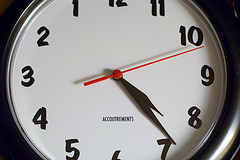Posted on 10 March 2012. Tags: congress, habit, love, sacrifice, sake, sunday morning, time of year, uniform time act, wake up time, world war
 It’s that time of year again. Kind of a love hate relationship. We loose an hour tonight, but that sacrifice will bring seemingly longer days as the sun stays bright later into the day. Officially Sunday Morning at 2AM the time will shift forward to 3AM leaving us all a little more tired come wake up time.
It’s that time of year again. Kind of a love hate relationship. We loose an hour tonight, but that sacrifice will bring seemingly longer days as the sun stays bright later into the day. Officially Sunday Morning at 2AM the time will shift forward to 3AM leaving us all a little more tired come wake up time.
If you think the change is a little early, then you might still be getting used to the changes enacted by congress a few years ago. “Spring Forward” used to occur the first Sunday of April. The changes create more Daylight savings in for the year and are supposed to save energy.
The Uniform time Act created in 1966 was the first widespread use of daylight savings. Previously the idea credited to Bejamin Franklin was used during World War I for its energy savings. The law was reformed in 1986 and then again in 2006 when it was lengthened for the sake of more energy savings.
Daylight savings changes are an excellent time to remember to change your batteries in all of you fire alarms and check that they are in working order and not expired. If you get in the habit of doing that twice a year corresponding the change, you can be sure that it gets done. Experts recommend changing the batteries twice a year to prevent fire alarm failures.
Daylight saving time goes through the first sunday in November.
Posted in Featured News, Nation and World
Posted on 21 February 2011. Tags: automobile sector, collapse, consumption, food services, holiday season, household, pace, seven months, time of year, united states
 Sales in the US retail market slowed abruptly in January, according to the official data released on Tuesday. The weak retail sales were brought about the huge snow storms that affected several parts of the country in the beginning of the year.
Sales in the US retail market slowed abruptly in January, according to the official data released on Tuesday. The weak retail sales were brought about the huge snow storms that affected several parts of the country in the beginning of the year.
From December, sales only increased to 0.3 percent, which shows the slowest rise in the market in seven months. The figures were based on the Commerce Department data that was adjusted for the given time of year.
In fact, the sector adjusted the December rise to 0.5 percent, where it was initially estimated to be 0.6 percent.
The pace in retail sales, as well as food services missed out the 0.5 percent increase analysts foretold, even though many stores featured sharp discounts after the holiday season.
Since January 2010, retail sales have increased to 7.8 percent based on a 12-month period. By December, retail sales merely climbed to 0.3 percent, which was barely half of the rise expected. However, the numbers excluded the automobile sector whose sales vary per month.
Garden supplies and building material dealers were the most affected area in the market. Their sales dived to 2.9 percent because of relentless winter weather and the collapse in housing markets.
The weak start of the year came after an upbeat recovery in the 2010 post recession period. That time, retail sales increased to 6.6 percent, which was the largest yearly increase since 1999.
Consumer spending, whose main indicator is retail sales, determines two-thirds of the economic activity in United States. However, they do not get sales in the area of services, which signify two-thirds of the consumption in household by value.
Posted in Business
 It’s that time of year again. Kind of a love hate relationship. We loose an hour tonight, but that sacrifice will bring seemingly longer days as the sun stays bright later into the day. Officially Sunday Morning at 2AM the time will shift forward to 3AM leaving us all a little more tired come wake up time.
It’s that time of year again. Kind of a love hate relationship. We loose an hour tonight, but that sacrifice will bring seemingly longer days as the sun stays bright later into the day. Officially Sunday Morning at 2AM the time will shift forward to 3AM leaving us all a little more tired come wake up time.
 Sales in the US retail market slowed abruptly in January, according to the official data released on Tuesday. The weak retail sales were brought about the huge snow storms that affected several parts of the country in the beginning of the year.
Sales in the US retail market slowed abruptly in January, according to the official data released on Tuesday. The weak retail sales were brought about the huge snow storms that affected several parts of the country in the beginning of the year.